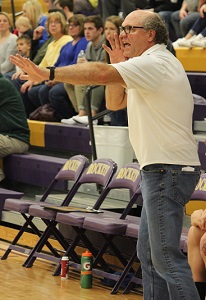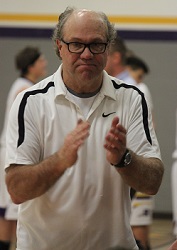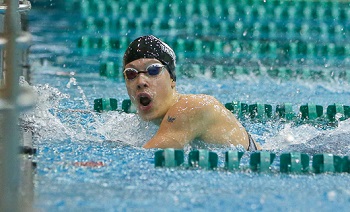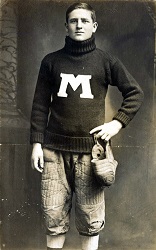
Branstrom-Led Mid Pen Built to Play Big
January 10, 2018
By Dennis Grall
Special for Second Half
ESCANABA - Mark Branstrom was a prolific scorer when he played at Perkins High School more than 40 years ago.
 Now, as coach of the Mid Peninsula Wolverines – the consolidated school that grew out of Perkins and Rock high schools in 1977 – defense has been the calling card for Branstrom as he tries to overcome the odds and put his players into competitive positions.
Now, as coach of the Mid Peninsula Wolverines – the consolidated school that grew out of Perkins and Rock high schools in 1977 – defense has been the calling card for Branstrom as he tries to overcome the odds and put his players into competitive positions.
"It might look ugly. We are not as good as anybody else but we can play defense with anybody," Branstrom said about developing an approach that gives Mid Pen – with just seven players on the varsity – a good chance to hang around against better teams with deeper rosters.
Branstrom became Mid Pen's coach in 1984-85, sitting out the 2007-09 seasons for health reasons. The Wolverines are off to a tough start this winter at 0-6, still searching for their first win and with a couple of close losses. But against heavy odds, he has guided Mid Pen to a pair of Class D District titles and one Regional championship and was selected Upper Peninsula Class D Coach of the Year in 2015-16.
That happens through diligent practice sessions, made easier perhaps because Branstrom has also served as junior varsity coach the past four years.
"Everyone knows their job," said Damian Richmond, a former player now with the revived program at Bay de Noc Community College in Escanaba. "He makes sure everyone is in their spot. He runs plays over and over in practice."
Branstrom, who has coached all three of his sons during his tenure, adopts a buddy-buddy approach with some players and serves as a father-son figure as well, according to Richmond. "He took me under his wing," said Richmond, who indicated Branstrom played a vital role in his decision to play college basketball after graduating from high school in 2016.
Branstrom's youngest son, Brett, is Mid Pen's all-time scoring (1,785) and rebounding (1,328) leader, a two-time Class D all-stater and later four-year regular at Northern Michigan University. He supplanted his brother Carl (1,161 points) as scoring leader. A sister, Hunter, scored 1,019 points. A third brother, Marcus, also played for his dad.
Mark Branstrom holds the scoring record at the former Perkins school, scoring 1,451 points for the Yellowjackets, who played in one of the smallest gyms in the state – typical of that day and age.
"The basketball floor is my element," said Branstrom. "I enjoy every aspect of it, and then I have the kids who respond. I get to teach (young) people who are like a sponge.
"There is never a time since I went into coaching that I did not think we had a chance to win, even against (three-time Class D champion) North Central these last few years."
 That was underlined in a recent game at Rapid River, which had halted North Central's state-record 84-game win streak Dec. 7. Mid Pen led much of the first half, using tough defense and a patient offense with Branstrom adroitly guiding everything from the sideline. That lasted until the Rockets settled in and scored the final nine points of the half en route to a 67-41 victory.
That was underlined in a recent game at Rapid River, which had halted North Central's state-record 84-game win streak Dec. 7. Mid Pen led much of the first half, using tough defense and a patient offense with Branstrom adroitly guiding everything from the sideline. That lasted until the Rockets settled in and scored the final nine points of the half en route to a 67-41 victory.
"The hardest thing is to get them to communicate on the floor defensively," said Branstrom. "It is like a musical for me to sit there and watch them when they communicate on defense."
Rick Pepin, now Rapid River athletic director but a former coaching opponent of Branstrom, knew what he was getting into against the Wolverines.
"He's always done a great job forcing tempo to fit his style. He never lets his kids play outside of their ability," said Pepin after that recent game in Rapid River.
Branstrom, who has mellowed considerably in recent years, now understands another side of coaching better. "Everything happens for a reason," he said, recalling his earlier days when he was prowling the sidelines with a hot temper.
"I get along with people a lot better (now). There is so much more to basketball than just basketball," he said with a twinkle in his eye. He said long-time basketball referee Dave St. Onge of Marquette was a factor in that change, telling him once "you've got to enjoy this."
Coaching the jayvees has also helped in that adjustment. "It is energizing to the point it has made me a better coach at the next level," he said. "This year I've literally had to collect kids just to have a jayvee team (three of the starting five are in their first year of basketball)."
That underscores why he has stayed on the sidelines. "It is for the love of it. I extremely enjoy it," Branstrom said. "I'm doing something for the kids."
His two teams will practice together, and varsity players will serve as assistant coaches.
The response of his players has kept Branstrom motivated to be in the gym and handle the extensive travel during the winter. His family also lived briefly in Coldwater and White Pine before finally settling in Perkins prior to high school, and he said a childhood friend in White Pine was a big influence.
Ward Helakoski is the son of Ed Helakoski, who directed Chassell to a then-state record 65 straight wins and three consecutive Class D basketball titles in the 1950s. Young Helakoski was a good all-around athlete and excellent student. "He helped me out considerably. My grades improved and I stayed eligible," Branstrom said, adding, "I dedicated myself to basketball when we moved to Perkins because we had no football."
He has remained dedicated, to the sport and to his players, through all the ups and downs of his profession. "I won't leave," he said. "I think I do a pretty decent job. If I wasn't, I would leave. You have to be dedicated to the kids, and I am extremely dedicated and loyal to the kids.
"I love Class D basketball. We have one of the best Class D (basketball) conferences in the state. The competitive level is to the point where the level of play has gotten so good."
 However, he has seen how declining enrollments impact the game, noting the 67 students at Mid Pen face Class D schools with enrollments just shy of the Class C level. "Getting to twice or three times the enrollment levels in the same class is not good," said Branstrom.
However, he has seen how declining enrollments impact the game, noting the 67 students at Mid Pen face Class D schools with enrollments just shy of the Class C level. "Getting to twice or three times the enrollment levels in the same class is not good," said Branstrom.
More than a dozen U.P. schools have enrollments below 80 students. But those are the kind of challenges that also motivate Branstrom and his athletes. Branstrom also was cross country coach for the Mid Pen boys and girls teams last fall, guiding the girls to a Division 3 runner-up finish in the Upper Peninsula.
He believes the farming, rural community is beneficial in the work ethic displayed by many U.P. athletes. "They seem to work harder," he said, noting their academic and athletic endeavors seem to confirm that observation.
Pepin recalls his battles against the Wolverines. "I have a tremendous amount of respect for Coach Branstrom," he said. "I watched him coach in the (lopsided) jayvee game (last week) and he never gave up, he never stopped coaching. He took every advantage to teach that team."
Pepin noted Branstrom was also teaching character and pride during that game. "Those are important character traits for life," he said.
"He has never given up on his community, his school, his student athletes. When Mark Branstrom is coaching our kids, they are better off. He makes your team play four quarters because he inspires his kids to play hard."
Basketball has obviously changed since Branstrom led the Upper Peninsula in scoring in 1974-75, with the inception of the 3-point shooting arc primary. "The mid-range game is not there anymore," said Branstrom, who worked that area of the floor. "In pick-up games and practices, they want to shoot those threes, and that has changed everything.
"The two-point shot is still worth so much more. The threes make it a more exciting game to come back (from a deficit), but it takes away from the scenario of the inside-out game. I like the mixture. I'm not for it, but I deal with it."
Dealing with players has also changed during his tenure, as he noted he could not coach today the way he did earlier in his career. "You've got to roll with the flow," he said, which includes adjusting to evolving basketball strategy and how a coach and player communicate. "If you don't change, you don't belong there," he said.
Branstrom has adjusted through the years and shows every night he is totally involved with the game and his players.
 Denny Grall retired in 2012 after 39 years at the Escanaba Daily Press and four at the Green Bay Press-Gazette, plus 15 months for WLST radio in Escanaba; he served as the Daily Press sports editor from 1970-80 and again from 1984-2012. Grall was inducted into the Upper Peninsula Sports Hall of Fame in 2002 and serves as its executive secretary. E-mail him at [email protected] with story ideas for the Upper Peninsula.
Denny Grall retired in 2012 after 39 years at the Escanaba Daily Press and four at the Green Bay Press-Gazette, plus 15 months for WLST radio in Escanaba; he served as the Daily Press sports editor from 1970-80 and again from 1984-2012. Grall was inducted into the Upper Peninsula Sports Hall of Fame in 2002 and serves as its executive secretary. E-mail him at [email protected] with story ideas for the Upper Peninsula.
PHOTOS: (Top) Coach Mark Branstrom of Rock Mid Peninsula talks to his varsity during a timeout at a recent game in Rapid River. Branstrom, who is also the junior varsity coach, has just seven boys on his varsity team. (Middle) Branstrom directs his team to back off on the tempo as the Wolverines bring the ball up court against the Rockets. Branstrom has been the Mid Pen coach since 1984-85 after playing at Perkins High School, which consolidated with Rock High School in 1978 to become Mid Pen. (Below) Branstrom applauds his team prior to pre-game introductions. (Photos by Dennis Grall.)

2018-19 Stacking Up With Best on Records
March 29, 2019
By Ron Pesch
Special for Second Half
What a sports year.
There certainly have been some amazing athletic feats over the 2018-19 high school season in Michigan, and it’s just two-thirds of the way complete.
This past fall, Kobe Clark of Schoolcraft scored nine touchdowns in a single game. Stunning!
The winter sports season saw Dylan Jergens of Marcellus Howardsville Christian top the MHSAA single season scoring record in boys basketball, finishing with 971 points. Incredible!
Then a freshman, Emoni Bates, hits for 31 points in an MHSAA Semifinal for Ypsilanti Lincoln. Wow!
So, how does that compare to years past?
First, let’s hit the pool!
SWIMMING
Across the world, as well as in Michigan, record performances seem to fall regularly in swimming. I’m certainly no expert on the sport, but research seems to indicate that optimization of stroke count, kicks and other body positioning (and not a change in the density of H2O) impact the lowering of recorded times in the water. The continued synchronization and optimization of movement may mean we’ll see regular improvement for years to come.
It’s telling that MHSAA all class/division records in eight of the 12 events that make up a girls meet have been set this decade. The remaining four marks date to 2002 or 2007, and are held by Kara Lynn Joyce of Ann Arbor Pioneer or Allison Schmitt of Canton. Joyce, of course, went on to post 18 NCAA championships and four silver medals won during three Olympic competitions. A freestyle specialist, Schmitt won eight Olympic medals across the 2008, 2012 and 2016 games.
 This past fall, the triumphs of three athletes, in particular, stand out. Kathryn Ackerman set a new state mark in the 200 individual medley with a time of 1:57:25. A junior, Ackerman’s time should place nationally in the top 15 all-time. With the 2018 season complete, she now holds the top four times in the event according to the MHSAA record book.
This past fall, the triumphs of three athletes, in particular, stand out. Kathryn Ackerman set a new state mark in the 200 individual medley with a time of 1:57:25. A junior, Ackerman’s time should place nationally in the top 15 all-time. With the 2018 season complete, she now holds the top four times in the event according to the MHSAA record book.
Senior Ashley Turak sprinted to a new Division I record of 22.10 in the 50 freestyle for Harrison/Farmington on the first leg of the 200 freestyle relay, as well as a time of 22.20 in the 50 freestyle. Both those times also rank in the national record books within the top 15. The MHSAA All-Class/Division Final Meet mark still belongs to Joyce, who posted a time of 22.04, set while leading off the 200 freestyle relay team in the Class A 2002 preliminaries.
Turak again mesmerized the crowd, this time in the 100-yard freestyle, posting a time of 48.72 seconds to win the event. Again, Joyce holds the Michigan All-Class/Division mark with a then-national record time of 48:59 set in 2002.
This November, Grand Ledge junior Lola Mull fell less than a half-second short of her own state mark in the 500-yard freestyle, set in the 2017 preliminaries. Mull owns the state’s top three times in the event, while Schmitt ranks fourth on the list.
Sub 20
A winter sport in Michigan, boys swimming is no different, with records in 10 of the 12 events set in the 2010s. Cam Peel of Spring Lake became the first in state history to break 20 seconds in the 50-yard freestyle, accomplishing the milestone twice this March, first in the prelim race with a record time of 19.86 and again in the finals at 19.91. The marks surpassed the previous best, set by Henry Schutte of Grand Rapids Forest Hills Central one year ago, and also rank among the “Best of the Best” in the National Federation record book.
FOOTBALL
Clark’s nine touchdowns came in Schoolcraft’s 63-27 victory over previously undefeated Constantine in a Southwestern Athletic Conference contest. Thanks to steady rain in the first half, Schoolcraft stuck to the ground game, opening a 21-0 first quarter lead on three Clark touchdowns, one of eight yards, the second of 24, and the third of 10 yards. Constantine battled back to within eight points, 21-13 late in the second quarter, but Clark would score for Schoolcraft twice more during the final three minutes before halftime.
 Following a 24-yard scamper, a partially blocked punt would set up Clark’s fifth rushing TD from two yards out with under a minute remaining before the break. (This appears to be a great moment to note that five players have scored five touchdowns in a single quarter). Clark added two TDs in the third quarter and two in the fourth.
Following a 24-yard scamper, a partially blocked punt would set up Clark’s fifth rushing TD from two yards out with under a minute remaining before the break. (This appears to be a great moment to note that five players have scored five touchdowns in a single quarter). Clark added two TDs in the third quarter and two in the fourth.
Amazingly, Clark’s nine touchdowns and 54 points scored are not state records. In fact, two others have matched the touchdown and point count, while three others have exceeded the accomplishment in each category. Of course, each of those events occurred at least 90 years ago, decades before the introduction of the mercy rule in high school football.
For many years, Herb Dunphy was listed as the state’s record holder for a pair of seemingly untouchable records: touchdowns in a single game and points scored in a game. In 1917 he scored 10 TDs for Lansing Central and stood alone at the top.
But as time has proven again and again, the work of historians and researchers can alter what we believe. In 1986, research by Tom Pellow of Gwinn uncovered that Marmaduke “Duke” Christie of Escanaba had also scored 10 touchdowns, matching Dunphy’s output. In addition, Christie added six point-after-touchdowns that day, totaling 66 points, as Escanaba defeated Ishpeming 102-0 in November 1920.
“In my humble opinion, Escanaba high school in 1920 had one of the greatest football teams that ever misunderstood a signal in any language,” wrote Cy DeLynes, recalling the exploits of Christie and his teammates in the Escanaba Daily Press in 1929. “Christie was its captain. The Duke had a pair of collapsible ankles and he was able to play in only a part of four games. That, however, was just enough time to permit him to score 21 touchdowns and 38 out of a possible 50 points after touchdown – a total of 164 points. He led a backfield that made Knute Rockne’s Four Horsemen look like a quartet of super-annuated milk wagon drivers turning off the alarm clocks at 4 o’clock in the morning.”
A few years later, additional study of yearbooks and newspapers revealed the exploits of Cecil Hardy of Flint Central, again reshaping the scoring entries in the MHSAA record book.
In the 1914 season opener – a 106-0 blasting of Lapeer – Hardy carried for more than 300 yards. Within the first two minutes of play, the captain of the Flint squad had scored the first of 11 touchdowns – a “new” state mark.
“His end running was the feature of the game, his longest run being one for 50 yards and a touchdown on the first play after the kickoff. Time after time as he was making his long runs he appeared to be tackled and would wriggle out of the grasp of his opponent and run 15 or 20 yards further,” was the report of the day.
“How Is This For Football?”
Muskegon 216, Hastings 0
The Boston Globe paired the question with the football score from a Michigan high school game to readers in their Sunday edition back on September 29, 1912.
“Most of Muskegon’s touchdowns were scored on the kick-off,” stated the Globe, “and few required more than one down.”
The score was believed to be a “world’s record” for points scored in a game, at the time. Indeed, the total ranks as the tops in Michigan. Indeed, it was a record nationally, but would be surpassed on three occasions in the coming years, first in 1923, again in 1924 and finally in 1927. With today’s employment of the running clock, the scoring totals will never again be approached.
The score was 40-0 at the end of the first quarter, 102-0 following the second, and 150-0 after three quarters. Touchdowns were scored by nine different players, with six scoring multiple times. As byproducts, captain Fred Jacks finished with nine touchdowns, while Muskegon’s Nelson Stuit booted 24 of 30 extra points in the contest (another state mark that also will never be equaled).
“Although world’s records fell in the game it is not anything to be particularly proud of …” stated the Muskegon Chronicle in the prose of the time. “The visitors had about three men that knew a football from an eff, and those three could not make the Muskegon second team.”
One of the best, as it turned out, was Fred Rehor, Hastings’ “big 220 pound fullback” who would later play for Michigan, then professional ball in Ohio for the 1917 Massillon Tigers, coached by Knute Rockne.
 As a result of the Muskegon-Hastings game, “at least three of the football elevens which contracted this year to meet Muskegon high school have begun to make excuses in line with those usually offered before a team quits such an engagement,” wrote the Lansing State Journal. Muskegon rolled up 499 points on the year, but ended a flawless season in defeat, 13-12 against rival Grand Rapids Central in the finale. The loss was blamed on overconfidence.
As a result of the Muskegon-Hastings game, “at least three of the football elevens which contracted this year to meet Muskegon high school have begun to make excuses in line with those usually offered before a team quits such an engagement,” wrote the Lansing State Journal. Muskegon rolled up 499 points on the year, but ended a flawless season in defeat, 13-12 against rival Grand Rapids Central in the finale. The loss was blamed on overconfidence.
The aptly named Francis Tallent of Menominee, became the next player to score nine TDs in a game.
Tallent’s skills on the gridiron had been spotted in 1928.
“Standing out like a missing tooth in a front row of the chorus … (Tallent) revealed as speedy a pair of heels as one could ever hope to cast his optics on in a high school game,” wrote one reporter after witnessing the left halfback’s performance in the annual twin cities battle between Menominee and Marinette, Wis., then played on Armistice day. Tallent scored twice in that “M & M” game, a 26-0 win by Menominee.
After thumping Green Bay in its 1929 season opener and a “helpless” Oshkosh Normal (now known as the University of Wisconsin-Oshkosh) freshmen team, 46-6, Menominee squared off for its game against “a light and green squad” from Kingsford.
According to the Milwaukee Journal Sentinel, Tallent scored nine touchdowns that day on runs of 46, 72, 90, 64, 50, 37, 90, 85 and 63 yards. In total, the paper noted that Tallent gained 597 yards rushing in the 150-0 thrashing of Kingsford. Other sources noted that it was likely more, as the sum of only the TD runs equaled the 597 yard total. Kingsford would finish its seven-game season without scoring a point. According to the Kingsfordian, the school’s high school annual, the Kingsford players “were no match for the heavier and more experienced teams on the range” that school year.
Menominee’s success and Tallent’s football exploits prompted the Journal-Sentinel to send a reporter to the U.P. to cover the 1929 M & M game between the border schools later that fall. “Mr. Tallent, who runs like the well-known hare and who slips out of tacklers’ arms and hands like a piece of wet soap, scored four touchdowns in the course of the afternoon,” wrote the staffer. “All told, this Mr. Tallent rolled up 284 yards,” as the “pride of the peninsula walloped Marinette,” 49-0, before a crowd of 10,000. The score was “the highest ever piled up in 45 years of bitter rivalry between the two cities.”
Menominee ended the 1929 season undefeated and untied in eight games, scoring over a point-a-minute while claiming the Upper Peninsula championship and demanding statewide consideration for Michigan’s mythical crown. Tallent finished the season with 27 touchdowns.
BASKETBALL
After 35 years, one began to wonder if Mark Brown’s single-season scoring mark, set in 1984-85 during his days at Hastings, would ever be surpassed. Brad Redford, named Michigan’s Mr. Basketball, came close as a senior in 2007-08, falling 17 points shy of exceeding Brown’s total of 969. Prior to that, only Drew Neitzel of Wyoming Park had come within reasonable striking distance, but that happened a decade and a half ago.
This year, Jergens of Howardsville Christian finally topped the total, finishing with 971 points. Jergens accomplished the task in 24 games, two games fewer than Brown, but with the advantage of the 3-point shot. The three was implemented after Brown had headed to college. According to press reports, Jergens had four games of at least 50 points during the season.
Still standing, 40 years later, is Jay Smith’s high school career scoring mark of 2,841 points, set at Mio between 1976 and 1979. Jergens finished third on the list with 2,782 career points, including 320 career 3-pointers – second most in state history. Brown ranks second with 2,789 points scored between 1982 and 1985.
 Freshmen
Freshmen
Few followers of prep basketball in Michigan could avoid coming across the name Emoni Bates, especially after the freshman phenom from Ypsilanti Lincoln knocked down 17 points in the Quarterfinals, 31 points in the Semifinal round of the Division 1 tournament, then 23 in the championship game. The immediate question on press row was, “Had another ninth grader ever exceeded his totals in a MHSAA final-rounds contests?” There was nothing to exceed it that I could recall.
While we’ve kept final round records, including single-game scoring marks, the website minimum is 40 points, and we’ve never captured a list that’s broken down by year in school.
So, I decided to dig.
Quarterfinals
The state has certainly seen some talented freshmen pass through the last rounds of the tournament. Monte Morris scored 20 points in the Quarterfinals for Flint Beecher during its Class C run in 2010. Saginaw Buena Vista played two freshmen, Mark Macon and Shawn Randolph, along its route to the Finals in 1984. Macon, at the age of 14, scored 22 points in a Quarterfinal win over Menominee that season. Two players scored 24 points in the quarters as freshmen: Flint Beecher’s Roy Marble, Jr. in 1982 in a loss to Okemos and Manton’s Matt Stuck, who scored 24 in defeat against Mio in 1989. But, according to Detroit Free Press accounts, it appears Michael Payton from Detroit St. Leo is the leading freshman point-getter in the Quarterfinal round. Payton netted 26 in a 74-62 loss to Flint St. Redeemer in the 1970 tournament.
Semifinals
Macon in 1984 and perhaps the most famous of freshmen in MHSAA Tournament history, Willie Betts of River Rouge in 1961, both scored 14 in Semifinal victories. Clyde Corley from Pontiac Central tossed in 16 points during a heartbreaking Semifinal defeat, 53-52, to Saginaw in 1976. Kelvin Torbert posted 17 points (and 10 rebounds) in a 65-62 Semifinal loss to Belleville in 1998. Morris tallied 18 in a loss to Melvindale Academy for Business & Technology in the Class C semis in 2010. So, Bates’ total of 31 certainly appears to top the list.
Finals
Only one freshman prior to Bates has hit for double digits in a state final. In 1992, Saginaw Buena Vista’s Terrance Roberson went 3 for 7 from the field and 4 for 7 from the free throw line to finish with 10 points as the Knights grabbed a 54-44 win over Grandville Calvin Christian.
Please, let me know if I missed a top performer.
 Ron Pesch has taken an active role in researching the history of MHSAA events since 1985 and began writing for MHSAA Finals programs in 1986, adding additional features and "flashbacks" in 1992. He inherited the title of MHSAA historian from the late Dick Kishpaugh following the 1993-94 school year, and resides in Muskegon. Contact him at [email protected] with ideas for historical articles.
Ron Pesch has taken an active role in researching the history of MHSAA events since 1985 and began writing for MHSAA Finals programs in 1986, adding additional features and "flashbacks" in 1992. He inherited the title of MHSAA historian from the late Dick Kishpaugh following the 1993-94 school year, and resides in Muskegon. Contact him at [email protected] with ideas for historical articles.
PHOTOS: (Top) Grand Haven’s Kathryn Ackerman swims the breaststroke portion of her record-setting 200-yard individual medley this past fall. (Top middle) Harrison-Farmington’s Ashley Turak looks to the clock after her 100 freestyle at the Lower Peninsula Division 1 Finals. (Middle) Schoolcraft’s Kobe Clark. (Middle below) Muskegon's Fred Jacks. (Below) Ypsilanti Lincoln’s Emoni Bates fires a jumper during his team’s Division 1 Semifinal win over Howell

